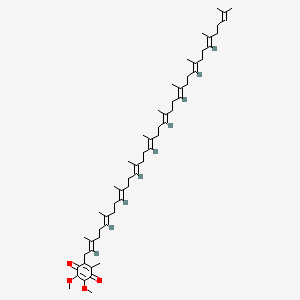Coenzyme Q10
Coenzyme q10 is a lipid of Prenol Lipids (PR) class. Coenzyme q10 is associated with abnormalities such as Nephrotic Syndrome, Diabetes, COENZYME Q10 DEFICIENCY, Deafness and Hypertensive disease. The involved functions are known as Mutation, Process, Oxidation, Electron Transport and Oxidants. Coenzyme q10 often locates in Mitochondria, soluble, Plasma membrane, Body tissue and Inner mitochondrial membrane. The associated genes with Coenzyme Q10 are MT-CYB gene, ATP5B gene, cytochrome c'', STN gene and NPC1 gene. The related lipids are Total cholesterol and Lipid Peroxides. The related experimental models are Mouse Model.
References related to abnormalities published in Others
| PMID | Journal | Published Date | Author | Title |
|---|---|---|---|---|
| 9012647 | Arterioscler. Thromb. Vasc. Biol. | 1997 | de Rijke YB et al. | The redox status of coenzyme Q10 in total LDL as an indicator of in vivo oxidative modification. Studies on subjects with familial combined hyperlipidemia. |
| 17412732 | Brain | 2007 | Gempel K et al. | The myopathic form of coenzyme Q10 deficiency is caused by mutations in the electron-transferring-flavoprotein dehydrogenase (ETFDH) gene. |
| 16905642 | Am. J. Epidemiol. | 2006 | de Lau LM et al. | Serum cholesterol levels and the risk of Parkinson's disease. |
| 23267110 | Proc. Natl. Acad. Sci. U.S.A. | 2013 | Shi TJ et al. | Coenzyme Q10 prevents peripheral neuropathy and attenuates neuron loss in the db-/db- mouse, a type 2 diabetes model. |
| 27406740 | Am. J. Physiol. Endocrinol. Metab. | 2016 | Sheeran FL and Pepe S | Posttranslational modifications and dysfunction of mitochondrial enzymes in human heart failure. |
| 25511910 | J Trace Elem Med Biol | 2015 | Alehagen U and Aaseth J | Selenium and coenzyme Q10 interrelationship in cardiovascular diseases--A clinician's point of view. |
